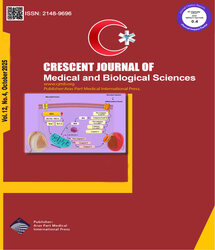

| Original Article | |
| Pulmonary Embolism During Pregnancy and the Postpartum Period: Incidence, Intensive Care Management and Outcome | |
| Farnaz Moslemi1, Sousan Rasooli1, Elshan Khoshnevis2 | |
| 1Associate Professor of Anesthesia, Women’s Reproductive Health Research Center, Department of Anesthesia, Alzahra Teaching Hospital, School of Medicine, Tabriz University of Medical Sciences, Tabriz, Iran 2Medical Research Committee, Azad University of Medical Sciences, Tabriz, Iran |
|
|
CJMB 2016; 3: 132-135 Viewed : 5696 times Downloaded : 3969 times. Keywords : pulmonary embolism, pregnancy, obstetric ICU |
|
| Full Text(PDF) | Related Articles | |
| Abstract | |
Objective: Pregnant people pose some challenge to the intensivists and their management is clinically important in the intensive care unit (ICU). Thrombotic events and pulmonary embolism (PE) is one of the most important causes of maternal morbidity and mortality. The aim of this study is to evaluate the incidence, diagnostic approaches, therapeutic interventions, intensive care management and outcome of parturient admitted to obstetric intensive care which were suspected to have PE. Materials and Methods: In this study, all pregnant or postpartum women with the sign or symptoms of PE which admitted to obstetric ICU of Alzahra teaching hospital during 5 years were reviewed. Demographic data, clinical signs or symptoms, diagnostic approaches, patient management and final outcome of the patients were collected, noted and analyzed. Results: Totally 200 parturient with the suspicion to have PE were admitted to ICU during 5 years. Mean age, weight and height of patients were 26.61 ± 4.28 years, 75.24 ± 3.06 kg and 157.87±7.89 cm, respectively. 136 (68%) patients were assessed carefully with imaging techniques and pulmonary emboli PE was ruled out in 124 (62%) patients whose CT was normal and 76 (38%) revealed unilateral (59 patients) or bilateral (8 patients) PE. Mean admission time was 7 days and overall mortality was 2.6% (2 patients). Conclusion: PE is an important cause of pregnancy-related mortality and morbidity and can mimic many other clinical conditions. However, high index of suspicion, accurate diagnostic approaches and timely prophylaxis and therapy can prevent maternal mortality. |
Cite By, Google Scholar
Online Submission System
 CJMB ENDNOTE ® Style
CJMB ENDNOTE ® Style
 Tutorials
Tutorials
 Publication Charge
Medical and Biological Research Center
About Journal
Publication Charge
Medical and Biological Research Center
About Journal
Aras Part Medical International Press Editor-in-Chief
Arash Khaki
Deputy Editor
Zafer Akan

















